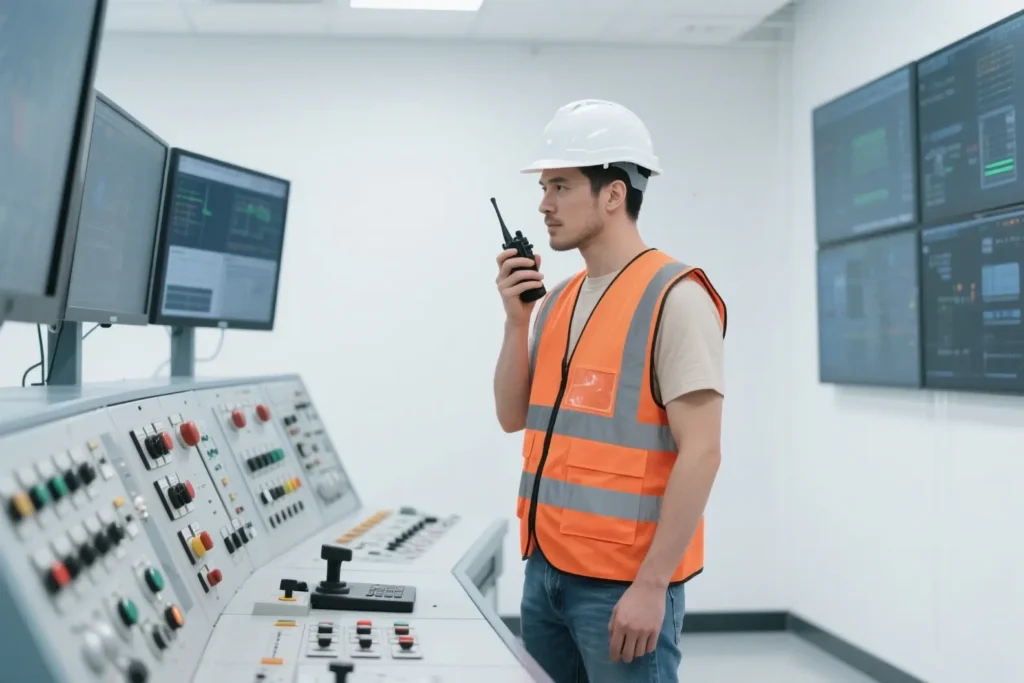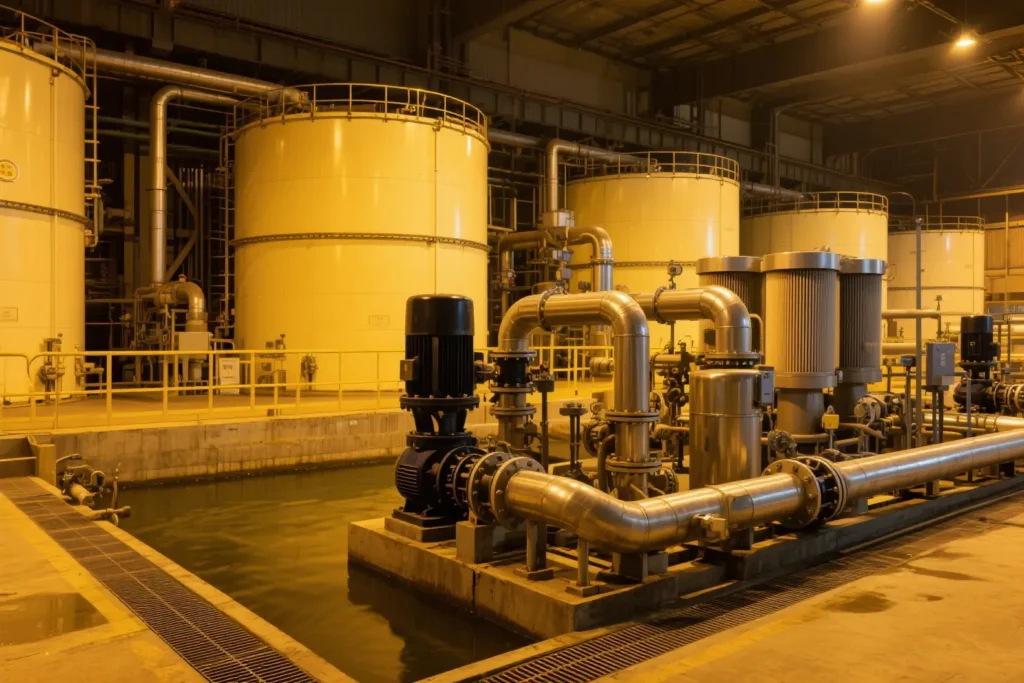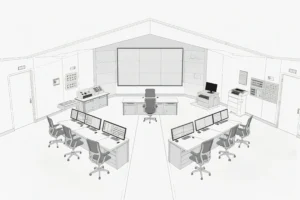As a control room console manufacturer, we often deal with power plant projects. But do you really understand power plants?
What’s a Power Station Control Room, Really?
Step into a power station control room, and you’ll feel it right away—this isn’t just another work area. It’s the core of the plant. Where I come from—building and outfitting these rooms—we call it the nerve center for a reason. It’s not just the control hub of a control room power plant. It’s where decisions ripple out across the entire facility.
Everything that happens in a plant flows through the power station control room. Data from turbines, boilers, generators, environmental sensors—it all lands here. And it’s not just about collecting it. The real job is making sense of it, fast.
If you’ve ever seen an airport control tower, it’s a good comparison. But instead of tracking planes, operators here are managing energy flows. A slight spike in pressure, a drop in turbine load, or a cooling system running too hot—it all matters. And someone in the power station control room has to respond in seconds, not minutes.
The room is built for that kind of pressure. I’ve seen setups where operators can isolate a fault, shut down a unit, or trigger alarms without even getting up from their chair. That kind of design isn’t about comfort—it’s about control, and in a power station control room, that control must be absolute.
Every plant is different. Coal, wind, nuclear—they all have their quirks. But the mission inside the power station control room stays the same: monitor, control, and react. When it’s done well, you don’t just keep the plant running—you keep it running safely, efficiently, and in step with everything from grid demand to regulatory rules.

What a Power Station Control Room Really Does
If you haven’t worked in one, it’s easy to picture the power station control room as just a high-tech office. Some folks think operators are just sitting there watching monitors. But once you’ve seen the pace during a turbine trip or an unexpected grid fluctuation, you realize—this room is where the plant thinks.
At its core, the power station control room is about centralized command. Instead of running around to inspect equipment, operators sit at a single workstation with full visibility over the plant. Temp, pressure, flow, voltage—it’s all there. I’ve seen installations where a team of two can run a whole site, just by keeping a close eye on the right data.
Safety? It’s built into every detail. Power station control rooms are typically placed away from high-voltage zones, shielded from fire hazards, even blast-rated in some plants. And the tools they use? Designed to act fast. I remember one project where we added dedicated emergency panels after a close call—operators could now cut power to key subsystems in under two seconds.
Then there’s efficiency. With advanced visualizations—dashboards, trend lines, predictive alerts—operators can do more than react. They can optimize. Faster startups, smoother shutdowns, less fuel waste. Every tweak adds up over time, especially in a high-performing power station control room. That’s what defines a truly modern power plant control room—more than just screens and data, it’s a platform for smarter operations.
And compliance is part of the picture too. You’ve got to meet industry standards—EMC shielding, grounding specs, cybersecurity, operator fatigue rules (Bhamare et al., 2020). One missed detail in console layout or data access, and you’re looking at audit failures or worse. That’s why every power station control room needs precision engineering.
Finally, the power station control room keeps everyone connected. I’ve worked on systems where operators coordinated with field crews across 10+ kilometers of pipeline. Voice, data, video—doesn’t matter. In this room, communication is the lifeline.
Bottom line? The power station control room doesn’t just watch the plant. It runs.
One Size Doesn’t Fit All: Control Rooms by Plant Type
Here’s something you learn fast in this field: every plant type needs a different kind of power station control room. You can’t build a wind farm console the same way you’d build one for nuclear power.
In coal-fired plants, you’ve got to manage complex combustion systems. Operators in the power station control room need access to furnace temps, air/fuel ratios, ash handling, emission controls—it’s a balancing act. And with emissions rules tightening, they need that data fast and clear.
Gas-fired plants—especially combined-cycle ones—move faster. The control systems in the power station control room need to be nimble, switching between steam and gas modes with little notice. We once redesigned an interface just so operators could see both turbine systems side by side during peak demand.
In nuclear plants, everything is layered with redundancy. These power station control rooms are built for absolute reliability. I’ve seen triple-redundant alarm systems, independent battery banks, and hardwired overrides built into a single console (IAEA, 2008). One plant we worked with had simulation training stations right next to the live controls. That’s how high the stakes are.
Hydropower shifts the focus. Water flow, reservoir levels, grid timing—it’s all in play. Sometimes you’re dealing with seasonal fluctuations, sometimes with sudden weather changes. The power station control room here leans heavily on forecasting tools and real-time dispatch updates.
Solar and wind farms are often remote and distributed. You might have a single power station control room monitoring hundreds of turbines or PV arrays spread across a wide area. These setups depend on SCADA systems, weather feeds, and remote diagnostics. You won’t always have someone on site—so your power station control room has to do the heavy lifting.
Even diesel, geothermal, or biomass plants have their own needs. They might be backup sources or small-scale operations, but they still require a responsive power station control room for quick startup, feedstock tracking, and integration with broader systems.
No matter the source, the principles stay the same: clarity, responsiveness, and operator control. But the design? That has to fit the energy you’re working with—and the demands of the power station control room.

What’s Inside a Power Station Control Room
Let’s get into the guts of it. What do you actually see when you walk into a modern power station control room?
It starts with the DCS—the Distributed Control System. This is the central brain. It connects all the inputs and outputs—sensors, actuators, logic controllers—and brings them into one interface. One change here can shift how a generator runs, how a valve behaves, or how a temperature curve gets controlled within the power station control room.
SCADA systems take that further—especially in renewable plants. They pull in data from multiple remote sources and let operators manage them centrally. That’s key for a power station control room handling wide-scale energy assets (Iacob et al., 2009).
Then you’ve got PLCs—programmable logic controllers. These automate the routine stuff: opening valves, switching pumps, adjusting flow rates. They’re fast, sturdy, and built to run for years without hiccups—ideal for the rigors of a power station control room.
To visualize it all, operators use HMIs—Human-Machine Interfaces. Big touchscreens, video walls, or multi-monitor setups that show status, trends, alerts. If it’s done well, an operator in the power station control room can glance up and spot a problem before it becomes one.
On the communication side, you’ll find a mix of tools—radios, VoIP, intercoms—often with redundancy baked in. If one line fails, there’s always another. I’ve worked on power station control rooms where even satellite phones were part of the kit.
KVM-over-IP setups are becoming more common too. These let operators control multiple machines with just one keyboard, monitor, and mouse. It keeps things neat, flexible, and easy to reconfigure inside the power station control room.
And let’s not forget the environment. These rooms are built for long shifts. That means climate control, clean air systems, proper lighting, acoustic treatment, and ergonomic desks. You can’t afford fatigue when you’re running a power station control room.
Truth is, a good power station control room isn’t just about the equipment—it’s about what it lets people do. And when it’s designed right, it becomes invisible. Operators don’t have to think about their tools. They just act. Quickly, safely, and with confidence.
Final Thought
I’ve seen all kinds of power station control rooms—small ones, high-end ones, emergency retrofits, even mobile setups. But no matter where they are or what energy they support, the best ones always have something in common: they’re built with the operator in mind. Because when pressure hits, it’s not the tech that makes the difference—it’s the person sitting at the console.
And our job? It’s to make sure that person has everything they need, right where they need it—in the power station control room.


